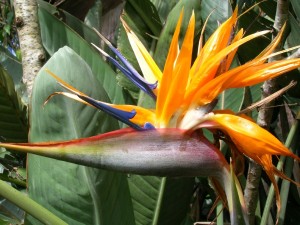 We were asked how and where the Strelitzia seeds are made and especially if this is possible at home. This is why we describe in this article the fertilization of the Strelitzia (Bird of paradise).
We were asked how and where the Strelitzia seeds are made and especially if this is possible at home. This is why we describe in this article the fertilization of the Strelitzia (Bird of paradise).
Strelitzia in the wild
Who fertilizes the Strelitzia in nature is not completely clear and is still being researched. It is known that insects, including bees, do visit the flower. The flower is also visited by honeysuckers (Nectariniidae) but it seems as if this bird is able to reach the nectar without touching the fertile parts of the flower.
The flower 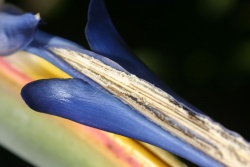
On the horn-shaped horizontal sepal, 4 to 6 flowers are formed with bright orange petals. The fertile parts are in the horizontal blue’ arrow’.
The stamens become visible when the wings on the back of the blue arrow are pressed together. The stigma is the white tip at the front of the blue arrow, which becomes sticky and therefore receivable as soon as the stamens no longer spread pollen.
The fertilization
As indicated earlier, the plant cannot fertilize itself. However, the Strelitzia is often sold planted as several plants in one pot. When these different plants bloom, they can be fertilized by hand.
First the pollen must be collected. This can be done by gently opening the stamens and carefully run the tip of a straw over the stamens from base to tip. The pollen can then be stored in the refrigerator. As soon as another plant blooms and the stigmas are receptive (sticky), the collected pollen can be sprinkled onto the stigmas.
The seedpods
Approximately four weeks after successful fertilisation, a seedpod of the size of a passion fruit is formed in the horizontal sepal. This seed box is divided into three compartments and can contain up to 80 hard round black seeds with the typical orange threads. When the seed is ripe, the seed boxes burst open.
© La Palmeraie
Source:
http://culturesheet.org/strelitziaceae:strelitzia:reginae
Photos: Forest & Kim Starr




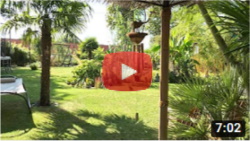


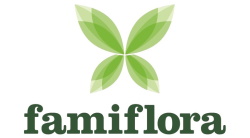





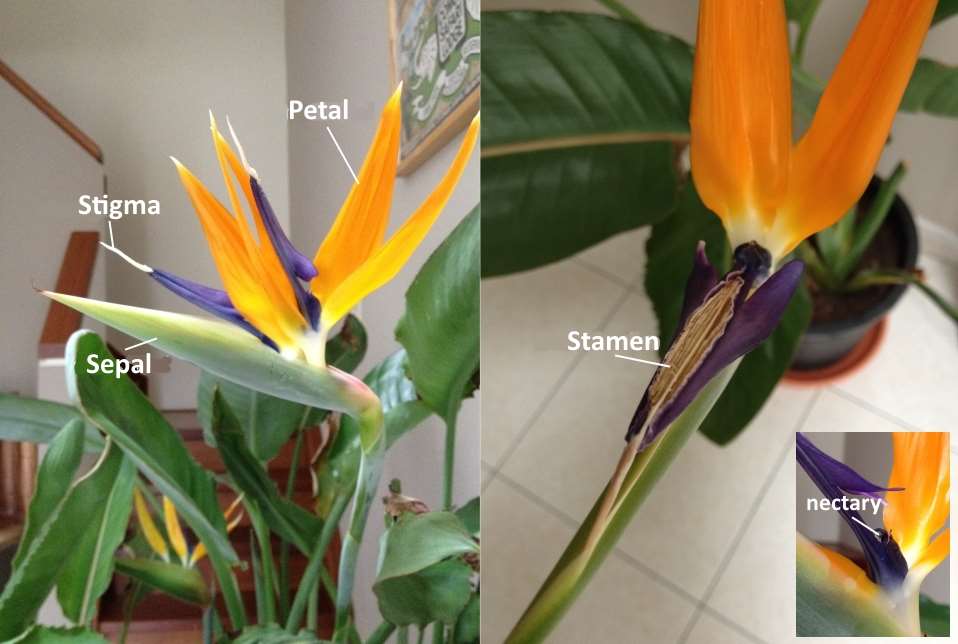






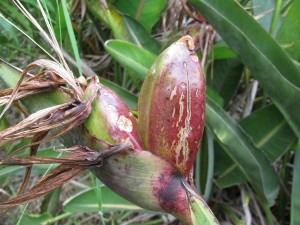
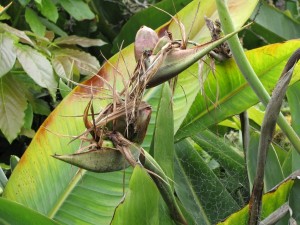
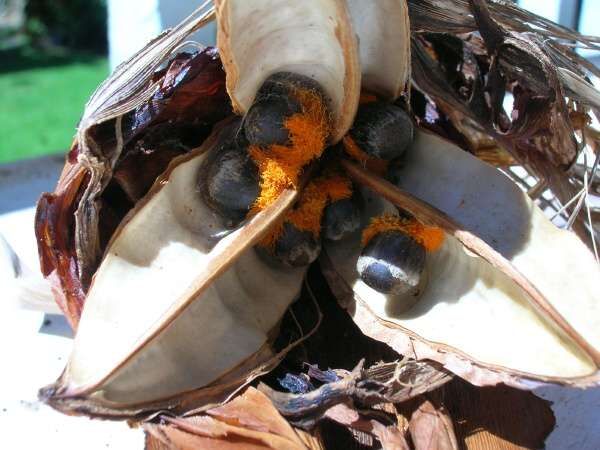
Reactie door Ian Fowler — 4 juli 2020 00:29 @ 00:29
Strelitzias are protogynous(protogynic)not protandrical. The pistil becomes receptive to pollen (i.e. sticky) soon after it emerges from the spathe. At this stage the pollen is not readily removed from the anther. While this does prevent fertilisation of each flower with its own pollen, strelitzias are clumping plants that when well established produce several flowers whith some at different stages of maturity. Hence can produce seed geitonogamously.However this may be very limited in nature given the comparitively small amounts of pollen likely to be transfered between flowers and apparent subsidiary biological mechanisms that inhibit self-fertisation. http://en.cnki.com.cn/Article_en/CJFDTOTAL-BJLY200102010.htm
Reactie door lapalmeraie — 4 juli 2020 09:01 @ 09:01
Hi Ian
Thank you for this most interesting comment. For those that aren’t familiar with these biological terms, it’s all about what is ready first; the pistil or the pollen. In fact there is very little information available on this specific subject and your url links to a Chinese database, not readable for me I’m afraid. If you have other resources I would be more happy to take knowledge of them!
This said, for most readers it’s all about how to pollinate the flowers at home so this discussion is rather irrelevant but ofcourse I do want to publish correct information only.
Kind regards
La Palmeraie
Reactie door Ian Fowler — 5 juli 2020 02:45 @ 02:45
I have experience in pollenating and achieving successful fertilisation of Strelitzias. My response was not to simply point out technicalities. (Indeed, I wrote “pistil” when should have written “stigma”) The article was unhelpful in that readers could be misled so as to attempt to pollinate before the pollen was ripe. In each flower the stigma is receptive before the pollen is ripe not vice versa. Furthermore your readers may be led to believe that if they had only one plant that that would necessarily preclude fertilisation following hand pollination.
Reactie door lapalmeraie — 6 juli 2020 09:11 @ 09:11
Hi Ian
Again, thanks for sharing your experience. The document you shared by mail is the same as the url which doesn’t specify any further the exact order of ripening of the Strelitzia flower. As for all my articles, I do some serious research in reliable publications only, before stating whatsoever. I spent quite some time last weekend digging into this specific question again but to be honest, I still didn’t find a clear answer. I did find another article that stated the order of ripening as I did. First the pollen and then the pistil. As I said, I think it is very important to publish correct information only and I did do my research back then as well. Very little information can be found but to clear this one out once and forever I contacted the reference on this subject, the Kirstenbosch National Botanical Garden in South Africa. If necessary I will correct my article of course and I will keep you updated as well naturally.
I do not think that my article does “mislead” my readers as you stated. I had many positive reactions since the first publication back in 2011 (for the dutch and french versions) from readers that did succeed the hand pollination due to the article tips. It was also one of the first to have a clear and simple description of the flower’s anatomy with pictures. The article also does state that the flower can’t pollinate itself and that you need another plant to effectuate the pollination but if the plant is potted with other subjects (as is often the case here) you may be able to do so.
Kind regards
La Palmeraie
Reactie door Jules — 22 juni 2021 14:57 @ 14:57
I have only one plant with 4 – 5 flowers, each at different stages of development…..the first and older flowers have a series of petals, stigmas and stamens which unfold over a few weeks, while the younger flowers are still developing. Can I transfer pollen from one flower to a different one (an older one to a younger one) to produce successful fertilisation and seeds? I tried it last year with no seed production.
Reactie door lapalmeraie — 27 juni 2021 06:34 @ 06:34
Hi Jules
No it has to be a flower from a different plans as the plant can’t auto pollinate.
Kind regards
La Palmeraie
Reactie door Glenn — 13 december 2023 20:04 @ 20:04
Hello!
Some 15 years ago I bought Strelitzia seeds on a store in Amsterdam om vacation. Six seeds, that all developed to nice plants. However, I only experienced one to flower after ten years, being mostly inside at 400m above sea level in western part of Norway. Then I bought a plant led light two years ago, and after that experienced repeatedly flowering. Now, this month was the first time two flowering plants overlapped in time, so I googled for polination advice and found this excellent site! I have followed the procedure described and cross my fingers!
Thank you for this excellent site, I will repost when the seed pods hopefully have developed.
Regards,
Glenn
Reactie door lapalmeraie — 14 december 2023 09:39 @ 09:39
Hi Glenn
This was exactly why I wrote the article in the first place. Very little clear information can be found on this subject.
Fingers crossed and do not hesitate to repeat the pollination a couple of times to make sure you got the right moment.
Kind regards
La Palmeraie
Reactie door Glenn — 15 december 2023 19:23 @ 19:23
Hi, thought I would drop by with a small update that might be useful to beguinners like me: Two days after I followed the described pollination procedure, I see that the white spike sticking out of the purple part of the flower (which I now know is called the stigmas) has changed color. From white towards dark gray. Also in these two days, a new flower extraxted next to it with a white stigmas. So I will repeat the same procedure again!
Best regards
Glenn
Reactie door lapalmeraie — 17 december 2023 10:09 @ 10:09
Hi Glenn
Thanks for this update. It is indeed wise to repeat the procedure several times to raise the chances to pick the right moment.
Kind regards
La Palmeraie